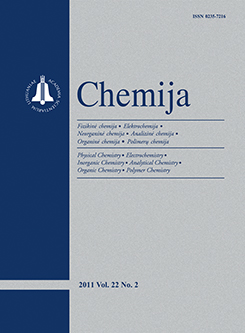 ISSN 0235-7216 ISSN 2424-4538 (online) |
2009 m. Nr. 1 The enzymatic reduction of pyridine N-oxide derivatives: the role of their electron accepting potency
The reduction reactions of a series of pyridine- and nitropyridine-N-oxide compounds by single-electron transferring flavoenzyme Anabaena PCC 7119 ferredoxin-NADP+ oxidoreductase (FNR, EC 1.18.1.2) were examined. The steady-state bimolecular rate constants (kcat / Km) of the reduction of pyridine N-oxides were determined to range between 1.3 × 101 and 2.0 × 104 M–1 s–1. The quantitative structure activity relationships (QSARs) were defined between the logarithm of the kcat / Km parameter of the compounds’ reduction and the energies of their lowest unoccupied molecular orbitals (ELUMO) obtained by quantum-mechanical methods. QSARs studies showed that the reactivity of pyridine Noxide derivatives was generally higher than that of nitroaromatic model compounds. The pyridine N-oxide as well as nitropyridine N-oxide derivatives proved to be more efficient substrates for the single-electron flavin-dependent enzyme than the model nitroaromatics and thus can be attributed to a new series of closely related compounds. This preliminary study may serve as a useful tool for predicting the enzymatic reactivity of structurally related compounds and may be used for analysis of their cytotoxicity with respect to the possible involvement of their redox cycling. Keywords: pyridine N-oxides, lowest unoccupied molecular orbital, electron transfer, ferredoxin reductase, quantitative structure activity relationship |
Issues:
2017 - Vol.28 No. 1, No. 2, No. 3, No. 4 2016 - Vol.27 No. 1, No. 2, No. 3, No. 4 2015 - Vol.26 No. 1, No. 2, No. 3, No. 4 2014 - Vol.25 No. 1, No. 2, No. 3, No. 4 2013 - Vol.24 No. 1, No. 2, No. 3, No. 4 2012 - Vol.23 No. 1, No. 2, No. 3, No. 4 2011 - Vol.22 No. 1, No. 2, No. 3, No. 4 2010 - Vol.21 No. 1, No. 2-4 2009 - Vol.20 No. 1, No. 2, No. 3, No. 4 2008 - Vol.19 No. 1, No. 2, No. 3-4 2007 - Vol.18 No. 1, No. 2, No. 3, No. 4 2006 - Vol.17 No. 1, No. 2-3, No. 4 2005 - Vol.16 No. 1, No. 2, No. 3-4 2004 - Vol.15 No. 1, No. 2, No. 3, No. 4 2003 - Vol.14 No. 1, No. 2, No. 3, No. 4 2002 - Vol.13 No. 1, No. 2, No. 3, No. 4 2001 - Vol.12 No. 1, No. 2, No. 3, No. 4 |